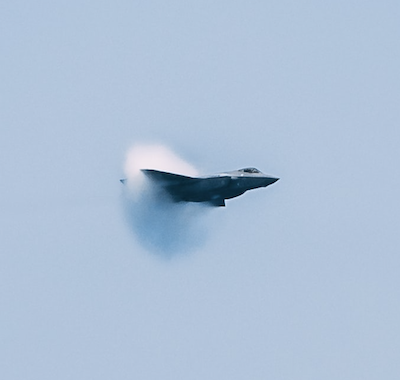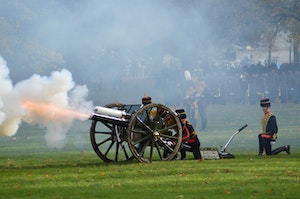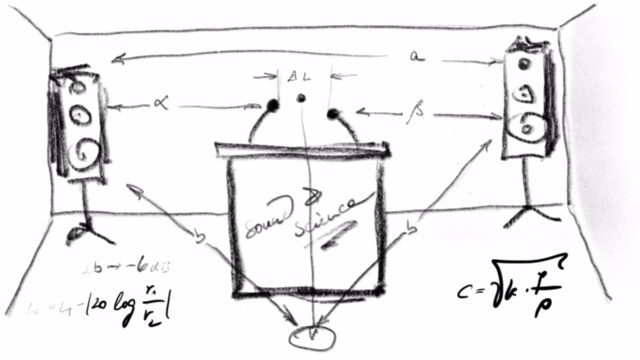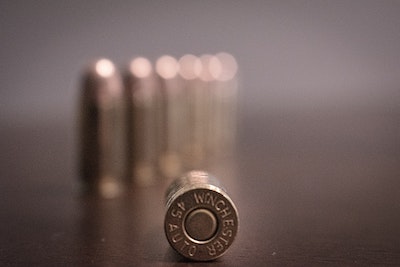
The speed of light is about 300.000 km/sec – a flash would travel to the moon in about one second. With the same speed the light-waves travel from objects into the sensor or the film in a camera. The speed of sound is so much slower – under normal earth-circumstances (1) it travels in air at about 300 m/sec (2).
Why are we talking about this? For realistic sound design we should at least know the consequences for a film that these facts may/should have – but in many films rarely do. Sure –film-sound does not have to be realistic but sometime it helps knowing your science / theory to create realism and sometimes it will help to be faster (calculating correct instead of guessing wrong delay-times for example) because you understand what you are doing and sometimes it will help discussing the sound with directors, producers – sometimes even with writers, who may assume wrong phantasies and misunderstandings to be physically correct (see example about noise-cancelling) and base a whole story on falsehoods.
Examples of physically wrong sound design would be:
- hearing the sound of thunder in sync with the lightning, that would only be realistic if the flash is dangerously close or nearly hits you, otherwise, as even kids know, the delay from seeing the flash to hearing the thunder tells you, how far the lightning has been away from you
- the sound of a firework is not im sync with the little explosions you see
- a distant rocket, a gun-shot, a tank-shot, cannons… should not sound in sync with firing the weapon
- there is no sound in space… but that’s another story…
Knowing about theory and physics can also help you being a better sound designer in many ways and it can also help you in creating sounds realistically and correct – if needed. Sometimes the more realistic approach is the one even more impressing and appealing.
some examples and helpful thoughts
1. about distant explosions, distant guns, cannons…

Calculating how much the sound should be delayed is obvious – with a travelling speed of 300 m/sec a tank or a cannon firing at a distance of roughly 400 m should be heard about 1,3 sec after you can see the explosion of the powder. In some films this is done correct like in “Full Metal Jacket” by Stanley Kubrick. In many films you will hear and see the firing in sync – no matter how far away the weapon might be. Quite often this unrealistic sound will not get noticed by the audience and when you think about the thunder-clap of lightning it is more impressing and has more impact in many situations – but sometimes its just wrong and simply not “better”.
2. about the sound of a PA-set in a hotel, theater or a stage

source: own illustration
Many people would just try some presets to get the sound of a PA – considering, that in most film situations there would not be a working PA-system – normally you would get just a normal recording of the actor or actress speaking into the microphone that most likely is not connected to anything. That’s just how film works – getting a PA and make it work with all the settings, cables… takes too much effort, too much time, too much money and in the end you get a not very flexible recording you may not want to use anyway. If you think about this situation from the perspective of the audience you may hear some of the direct sound from the person taking, at least in the front row. The microphone would send the signal to the mixer/amp/speaker with practically no delay and the sound from the speaker would reach the audience a little bit later, because they are further away. The sound of the speakers may have two different delay-times depending if a “special character” of that film sits more to the right or more to the left. You also need to think about reverb, its delay and decay-time depending on the room, the walls…
Sitting 20 m from the speakers there would be a delay of 0,067 sec. If there would be the need of some feedback (short echo) from the speakers to the microphone and the speakers would be 10 m away from the microphone the delay-time would be 0,033 sec. You see – within seconds you will get a more realistic sound just by considering the right values – and this will save time for adjusting equipment too.
3. about the sound within a car or very small “rooms”
Sometimes you need to get the reverb or especially the first reflections of a sound in a very small room with special possibilities for fine-tuning – like if you have to add some ADR (dialog that has been recorded later in a studio for example) and the “location” is in a car. The problem is, that you have the sound of the original dialog in that car and you need to get the same sound from a recording done much later in a recording-studio – which can be very tricky and difficult (there is another article about matching the sound of ADR-recordings to location-recordings and more…). In this case it can help quite a lot if you know the the delay-time of the reverb or the first reflections by calculating it. If the distance from the actor / actress to the window of the car would be 50 cm the travelling time would be just 0,0016 sec – depending very much on where the recording microphone is / was. This means (with the standard sampling-rate of 48kHz in film) just about 80 samples. It can be timesaving not only to use a reverb or a delay for that but copy the “to be processed audio” to another track and just move it.
4. what sound will reach you first, the firing gun or the impact of the bullet?

Once i had to make the sound for a film where somebody gets shot with a rifle. The police will find out that the murder shot from another house some 300 m away. The camera-position is quite close to the one who gets shot (in some movies you can even see the bullet hitting). With the help of the internet you will find out, that the travelling speed of bullets can exceed 3000 m/sec. So when the “bullet hits the actor” there could be a delay of about a 1 sec for the sound of the firing from the rifle…
(1) so on earth with normal air-pressure – not on another planet with other gases and a different pressure
(2) the travelling speed depends also on the material, for example in water the speed of sound is much higher (about 1480 m/sec) – where the temperature of the water has some influence too…
